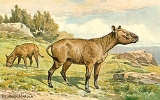
Hyracodontidae
Encyclopedia
Hyracodontidae is an extinct
family
of rhinoceros
es endemic to North America
, Europe
, and Asia
during the Eocene
through early Miocene
living from 55.8—20 mya, existing for approximately .
They are typified as having long limbs and having no horns. These animals were initially modest in size and fast moving, having evolved from smaller members of Rhinocerotoidea during the Late Eocene and Early Oligocene. They later evolved into gigantic forms that included the largest terrestrial mammals ever to have lived (the Indricotheriinae
or Paraceratheriinae
).
Hyracodonotidae thrived in the rainforest
s of Kazakhstan
, Pakistan
, and southwest China
, a former coastal region.
Extinction
In biology and ecology, extinction is the end of an organism or of a group of organisms , normally a species. The moment of extinction is generally considered to be the death of the last individual of the species, although the capacity to breed and recover may have been lost before this point...
family
Family (biology)
In biological classification, family is* a taxonomic rank. Other well-known ranks are life, domain, kingdom, phylum, class, order, genus, and species, with family fitting between order and genus. As for the other well-known ranks, there is the option of an immediately lower rank, indicated by the...
of rhinoceros
Rhinoceros
Rhinoceros , also known as rhino, is a group of five extant species of odd-toed ungulates in the family Rhinocerotidae. Two of these species are native to Africa and three to southern Asia....
es endemic to North America
North America
North America is a continent wholly within the Northern Hemisphere and almost wholly within the Western Hemisphere. It is also considered a northern subcontinent of the Americas...
, Europe
Europe
Europe is, by convention, one of the world's seven continents. Comprising the westernmost peninsula of Eurasia, Europe is generally 'divided' from Asia to its east by the watershed divides of the Ural and Caucasus Mountains, the Ural River, the Caspian and Black Seas, and the waterways connecting...
, and Asia
Asia
Asia is the world's largest and most populous continent, located primarily in the eastern and northern hemispheres. It covers 8.7% of the Earth's total surface area and with approximately 3.879 billion people, it hosts 60% of the world's current human population...
during the Eocene
Eocene
The Eocene Epoch, lasting from about 56 to 34 million years ago , is a major division of the geologic timescale and the second epoch of the Paleogene Period in the Cenozoic Era. The Eocene spans the time from the end of the Palaeocene Epoch to the beginning of the Oligocene Epoch. The start of the...
through early Miocene
Miocene
The Miocene is a geological epoch of the Neogene Period and extends from about . The Miocene was named by Sir Charles Lyell. Its name comes from the Greek words and and means "less recent" because it has 18% fewer modern sea invertebrates than the Pliocene. The Miocene follows the Oligocene...
living from 55.8—20 mya, existing for approximately .
They are typified as having long limbs and having no horns. These animals were initially modest in size and fast moving, having evolved from smaller members of Rhinocerotoidea during the Late Eocene and Early Oligocene. They later evolved into gigantic forms that included the largest terrestrial mammals ever to have lived (the Indricotheriinae
Indricotheriinae
Indricotheriinae is a subfamily of Hyracodontidae, a group of long-limbed, hornless rhinoceroses that evolved in the Eocene epoch and continued through to the early Miocene. The earlier hyracodontid species, such as Hyracodon were modest-sized, fast-running, lightly built animals with little...
or Paraceratheriinae
Indricotheriinae
Indricotheriinae is a subfamily of Hyracodontidae, a group of long-limbed, hornless rhinoceroses that evolved in the Eocene epoch and continued through to the early Miocene. The earlier hyracodontid species, such as Hyracodon were modest-sized, fast-running, lightly built animals with little...
).
Hyracodonotidae thrived in the rainforest
Rainforest
Rainforests are forests characterized by high rainfall, with definitions based on a minimum normal annual rainfall of 1750-2000 mm...
s of Kazakhstan
Kazakhstan
Kazakhstan , officially the Republic of Kazakhstan, is a transcontinental country in Central Asia and Eastern Europe. Ranked as the ninth largest country in the world, it is also the world's largest landlocked country; its territory of is greater than Western Europe...
, Pakistan
Pakistan
Pakistan , officially the Islamic Republic of Pakistan is a sovereign state in South Asia. It has a coastline along the Arabian Sea and the Gulf of Oman in the south and is bordered by Afghanistan and Iran in the west, India in the east and China in the far northeast. In the north, Tajikistan...
, and southwest China
Southwest China
Southwest China is a region of the People's Republic of China defined by governmental bureaus that includes the municipality of Chongqing, the provinces of Sichuan, Yunnan and Guizhou, and the Tibet Autonomous Region.-Provinces:-Municipalities:...
, a former coastal region.

